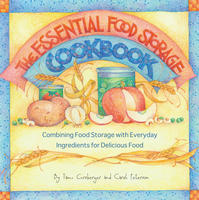
I recently (January 2008) finished reading The Essential Food Storage Cookbook by Tami Girsberger and Carol Peterson. I scanned or read all of the recipes as well as the text. The Introduction is good. It recognizes that there are many attitudes about food storage. The information in the first chapter is directed primarily at members of The Church of Jesus Christ of Latter-day Saints but has some good information about how to get started and offers some good tips about basic food storage. It seems to be directed at those who live in dry climates, though, when it addresses packaging recommendations. The packaging options it lists are also limited in scope and it doesn’t consider the option of home canning.
It seems that most people have forgotten that there are three kinds of food storage – basic, expanded, and emergency. In Essentials of Home Production and Storage, a booklet previously available from The Church of Jesus Christ of Latter-day Saints, it instructs us that Basic Storage is “life-sustaining foods and nonfood items that will store reasonably well for long periods.” Emergency Storage is emergency supplies in a portable container/s. Expanded Storage is “foods and other daily essentials to supply total nutritional needs and allow for variety and personal preferences in diet and living…These items may be stored in root cellars, or they may be bottled, canned, pickled, dehydrated, or freeze-dried…Because these foods have limited storage life, they should be used and replaced regularly.” Pantry foods are expanded food storage. The 3-month supply encouraged by the First Presidency of the Church is expanded food storage. This book defines food storage only in terms of basic food storage. What should be expanded food storage is only considered to be a well-stocked pantry.
There are some interesting and appealing recipes in this book, but I question why many of the recipes are included in a “food storage” cookbook with their abundance of fresh ingredients and relative lack of storable ingredients. They do, however, fulfill the subtitle of the book Combine Food Storage with Everyday Ingredients for Delicious Food even if the only food storage ingredient is maple syrup. (Over 80% use at least 1 fresh ingredient. Most of them use considerably more.) The book does include recipes for sweetened condensed milk, buttermilk (sour milk), evaporated milk, and whipped topping and has 6 eggless baking recipes (2 cookie, 1 brownie, 3 cakes) that are worth looking at.
As an author and publisher, I also look at formatting and proofing errors. This book seems to have been printed in a very short period of time. There are typographical errors, grammatical errors, and a whole lot of inconsistencies in recipe format. Ingredient size or variety are not always specified. Chapter order is strange to me – they are in alphabetical order instead of eating or preparation order, so Desserts are before Main Dishes. The cover design and interior illustrations are nice, though.
The index is very general. It doesn’t list all the recipes by name. Main ingredients are listed but recipes using them are only referred to by page number and not name.
Considering that you could find similar recipes to most of those in this book very easily in another cookbook, in a cooking magazine, or on-line, I wouldn’t recommend this book to someone who is looking to begin a food storage cookbook library. It’s a nice addition but not essential reading.
